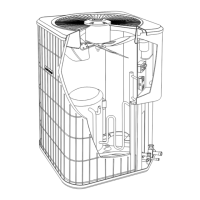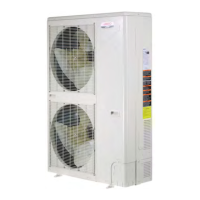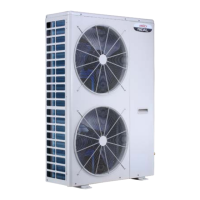
Do you have a question about the Lennox Value Series and is the answer not in the manual?
Details for the Value Series 10ACB Condensing Units, including model numbers and superseding information.
Describes the design of Value 10 condensing units for expansion valve (TXV) and RFC systems.
Lists the items included with the assembled 10ACB condensing unit and instructions for checking shipping damage.
General installation guidelines, code compliance, and safety notes on refrigerant venting under the Clean Air Act.
Warns about exposure to fiberglass wool during installation, maintenance, or repair, and potential health risks.
Provides diagrams and a table listing the dimensions for various 10ACB unit models in inches and millimeters.
Details required clearances for unit installation, slab mounting, and roof mounting, with diagrams.
Covers electrical wiring codes, grounding, line voltage, 24V circuits, and provides a field wiring diagram.
Instructions for refrigerant piping, line set selection, sweat connection procedures, and line kit details.
Information on RFCIV devices, drill sizes, and installation diagram for 10ACB units.
Highlights the importance of RFCIV removal for expansion valves and specifies 'low loss' manifold gauge set use.
Details on accessing service ports, opening/closing liquid/suction line valves, and their functions.
Critical danger warning against backseating valve stems, which can cause component failure and injury.
Strong warning against using oxygen for pressurization; emphasizes safe use of nitrogen or CO2.
Outlines procedures for leak testing using HCFC-22 and nitrogen, including pressure management.
Describes suction line service valves, including ball-type for 5-ton units, and provides operational diagrams.
Explains the critical need to remove non-condensables and water vapor to prevent system corrosion and details initial evacuation steps.
Covers the full evacuation process, achieving target vacuum levels, and breaking vacuum with nitrogen.
Warns against deep vacuum operation with compressors, which can cause internal arcing and damage.
Emphasizes energizing the crankcase heater 24 hours before start-up to prevent compressor slugging damage.
Provides a checklist for unit start-up and discusses initial charging considerations based on ambient temperature.
Table detailing adjustments to refrigerant charge based on line set diameter and length deviations from standard.
Explains Table 4 as a maintenance guide and details preparation steps for unit charging procedures.
Describes weighing-in and subcooling methods for charging RFC systems based on outdoor ambient temperature.
Details the weighing-in method (low ambient) and the approach method (high ambient) for charging TXV systems.
Covers system operation, crankcase heaters, compressor start kits, timed-off controls, and pressure switches.
Presents tables for subcooling values for RFC systems and approach temperature targets for TXV systems.
Critical warning to turn off electrical power before performing any service or maintenance to avoid shock hazards.
Covers essential maintenance tasks at the start of the cooling season, including condenser coil cleaning and inspection.
Details indoor unit maintenance like filter cleaning, blower adjustments, and checks for refrigerant sight glass installation.
Fields for recording essential job details, unit model, serial number, and nameplate specifications.
Checklist items to verify proper cooling section operation, including leak checks, valve status, and refrigerant charge.
Items to verify regarding thermostat settings, proper operation, and levelness for correct system control.












